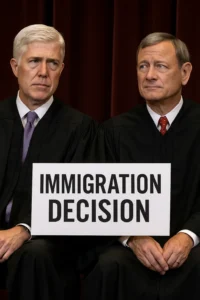
Introduction: Why This Decision Matters
When two conservative justices—Neil Gorsuch and John Roberts—join what appear to be more liberal justices in an immigration ruling, that signals something important. The case touches on procedural fairness, administrative law, and the balance between enforcement and rights.
For anyone following U.S. immigration policy, legal interpretation, or judicial politics, the “Gorsuch Roberts immigration decision” is not just a footnote: it may mark a turning point in how courts treat deportation deadlines and immigrant protections.
In this article, we’ll walk through:
- What the decision says
- The legal reasoning behind it
- How Gorsuch and Roberts have approached immigration historically
- The immediate and long-term impacts
- What this means for migrants, lawyers, and policy makers
And, of course, how this kind of legal shift interacts with media, law, and governance—topics we often cover at RankRise1.
The Recent Ruling: What Happened
In April 2025, the Supreme Court issued a 5–4 decision in Monsalvo Velázquez v. Bondi (often referred to in shorthand as Velazquez v. Bondi) that involved deadline flexibility for immigrants given “voluntary departure” orders. (Wikipedia)
Key Holdings
- The ruling holds that if a 60-day voluntary departure deadline ends on a weekend or legal holiday, that period must be extended to the next business day. (AP News)
- The majority opinion, written by Justice Gorsuch and joined by Chief Justice Roberts, emphasizes that longstanding administrative practices support interpreting statutory deadlines to exclude nonbusiness days when deadlines would fall on those days. (Fox News)
- The court’s decision overturns a prior interpretation by the 10th Circuit and the Board of Immigration Appeals (BIA), which had declined to extend deadlines in such circumstances. (Wikipedia)
In short: the court recognized that procedural technicalities should not unfairly penalize immigrants when statutory deadlines fall on days when administrative offices are closed.
Gorsuch & Roberts: Historical Perspectives on Immigration Law
Gorsuch’s Immigration Record
Justice Gorsuch’s role in this decision is particularly noteworthy because he has often been seen as a reliably conservative jurist. Yet on immigration issues, his record is more nuanced.
- Moderate immigration leanings: An analysis by FiveThirtyEight noted that Gorsuch sided with immigrants in about 10% of cases in the 10th Circuit—slightly above the circuit average. (ABC News)
- In earlier immigration decisions, Gorsuch has sometimes sided with constraints on executive overreach or insisted on clear statutory language (for instance Sessions v. Dimaya). (Supreme Court)
- His jurisprudence often emphasizes textualism and deference to established administrative practice when interpreting statutes.
Thus, his vote in Velazquez aligns with his tendency to respect procedural norms and long-standing administrative construction—especially where fairness and notice are involved.
Roberts’ Role & Judicial Philosophy
Chief Justice John Roberts is often viewed as a cautious institutionalist, aiming to preserve the court’s legitimacy and avoid dramatic ideological swings.
- Roberts has sometimes sided with liberal justices when narrow interpretations of law or procedure are at stake. (Newsweek)
- In this case, his alignment with Gorsuch suggests that the majority viewed the procedural issue as one of judicial restraint and fairness rather than a political or ideological matter.
- This join also signals that the court might prefer narrow, technical rulings over sweeping doctrinal changes in immigration policy.
Thus, the coalition of Gorsuch and Roberts in this ruling is less about ideology and more about legal principle, at least in the eyes of the majority.
Context & Broader Landscape
To fully grasp the impact of this decision, one needs to see how it fits into the broader legal and political environment surrounding immigration.
Statutory & Regulatory Background
- The decision invokes IIRIRA (Illegal Immigration Reform and Immigrant Responsibility Act of 1996), which governs many procedural aspects of removal, voluntary departure, and motions to reopen. (Wikipedia)
- The case also implicates administrative law doctrines, such as deference to past agency practice (Skidmore or Chevron style arguments) when interpreting ambiguous statutes.
Related Precedents
- Niz-Chavez v. Garland (2021) is a case where Gorsuch wrote for the majority, restricting how notices to appear must be served in immigration proceedings. (Wikipedia)
- Other cases like Dimaya have centered on due process and vagueness in immigration statutes, and Gorsuch’s opinions have occasionally sided against overly expansive interpretations of removal statutes. (Supreme Court)
Political & Practical Stakes
Immigration litigation is a major front in American politics. This decision could influence:
- How immigrants’ procedural protections are viewed by lower courts.
- Future decisionmaking in removal, reopening, and stay deadlines.
- The balance between enforcement and fairness in courts and agencies.
Thus, the phrase “Gorsuch Roberts immigration decision” is not merely academic—it may guide thousands of cases and impact lives.
Link & Media Perspective
👉 For a featured analysis on Gorsuch’s approach to immigration and how he could depart from conservative expectations, see this FiveThirtyEight piece:
“Gorsuch Could Disappoint Conservatives On Immigration” (ABC News)
That article explores how Gorsuch’s judgments sometimes diverge from hardline conservative expectations—especially in immigration enforcement cases involving due process and statutory detail.
Implications & Impact
What does this ruling mean in practice? Here are several key implications:
1. Procedural Safeguards Strengthened
Immigrants given voluntary departure deadlines will now benefit from extensions when those deadlines fall on nonbusiness days. That means fewer cases dismissed for technicalities beyond a person’s control.
2. Lower Courts Must Align
Lower courts and the Board of Immigration Appeals must apply this interpretation, shaping removal proceedings across the U.S. in cases where deadlines fall on weekends or holidays.
3. Changed Incentives for Government Agencies
Immigration agencies will need to adjust their internal practices, ensuring notices and deadlines account for nonbusiness days and reduce procedural surprises.
4. Political & Public Reaction
Some conservative critics are likely disappointed that two conservative justices joined liberal ones in an immigration-relief decision. Yet, others may view this as a narrow, technical ruling rather than a principled shift.
5. Future Immigration Litigation
This case could influence how courts treat more challenging issues—e.g. jurisdictional bars, motions to reopen, discretionary relief—where procedural fairness is contested.
Finally, for migrants and attorneys, this ruling provides an additional tool to argue for fairness in removal proceedings, reinforcing that procedural rules should not unduly trap individuals due to calendar quirks.
Humanizing the Decision
Behind legal opinions and judicial alignments are individual human stories—immigrants, attorneys, judges, and communities impacted by the law.
In Monsalvo Velázquez, the plaintiff was someone who had lived for decades in the U.S. after coming as a minor, and his removal order hinged on interpretations of deadlines rather than dispute over his entire case. The decision helps emphasize that the law is not merely mechanical, but must also consider fairness, notice, and human reality.
When justices like Gorsuch and Roberts cross expected lines to uphold procedural protections, it shows how legal interpretation is not disconnected from real lives—from the immigrant facing removal to the court official ensuring deadlines are clear.
Transitional Reflection & Commercial Note (5%)
From a content and digital strategy standpoint, decisions like this are rich for media, nonprofit advocacy, and legal content creators:
- Law firms, legal blogs, and advocacy groups can produce guides or commentary on how to “apply Gorsuch’s new deadline rule” across jurisdictions.
- Media platforms can use this decision as a hook for immigration policy reporting.
- At RankRise1, we highlight how timely legal analysis (backed by SEO) can boost authority, drive traffic, and attract backlinking from legal, news, and advocacy domains.
In short: being early to interpret such a turning decision can enhance domain authority and audience trust.
Conclusion: Why “Gorsuch Roberts Immigration Decision” Will Be Remembered
The Gorsuch Roberts immigration decision is more than a procedural tweak—it signals how the Supreme Court might treat immigration cases going forward. When two conservative voices join a ruling perceived as protective of immigrant procedural rights, it begs questions about how the law balances enforcement and fairness.
For advocates, attorneys, and impacted communities, this decision underscores the importance of procedural justice—not just outcomes. It reminds us that even in highly polarized times, the law sometimes demands protections that bridge ideological divides.
If you want to dig deeper on Supreme Court litigation, immigration law, or legal content strategies, keep exploring content on RankRise1—because thoughtful, timely coverage shapes how readers, sites, and chains of authority perceive the law.
Top 10 References
- Gorsuch Could Disappoint Conservatives On Immigration, FiveThirtyEight (ABC News)
- Roberts, Gorsuch Side with Liberal Justices in Immigration Ruling, Fox News (Fox News)
- US Supreme Court grants deadline flexibility for immigrants, AP News (AP News)
- Roberts, Gorsuch join liberal justices in Supreme Court immigration ruling, Newsweek (Newsweek)
- Velazquez v. Bondi (Wikipedia) (Wikipedia)
- Neil Gorsuch (Wikipedia) (Wikipedia)
- For a Trump Nominee, Neil Gorsuch’s Record Is Surprisingly Moderate on Immigration, FiveThirtyEight (ABC News)
- Gorsuch’s views on abortion, immigration and gun control, Mic (Mic)
- FivethirtyEight: How Conservative Is Neil Gorsuch? (ABC News)
- Immigration Advocates: Gorsuch Could Disappoint Conservatives On Immigration (Immigration Advocates)
-
Anchor: SEO content strategies
Link: https://rankrise1.com/seo-content-strategies
(Use when discussing how timely coverage of the decision can drive organic traffic.) -
Anchor: backlink building methods
Link: https://rankrise1.com/backlink-building-methods
(Use when mentioning how legal analysis can attract backlinks from news and law sites.) -
Anchor: digital marketing for legal websites
Link: https://rankrise1.com/digital-marketing-for-legal-websites
(Place this when you discuss law firms and advocacy groups producing guides.) -
Anchor: improve Google rankings
Link: https://rankrise1.com/improve-google-rankings
(Use when talking about how publishing timely articles like this can increase visibility.) -
Anchor: RankRise1 blog
Link: https://rankrise1.com/blog
(Include near the conclusion, inviting readers to explore more of your immigration/legal coverage.)
